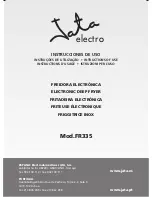
31
When making numerical changes, please keep in mind to stay within the programming limits shown on
page 34
-
page 38
. If an erroneous entry is made, the Phase 7 OPL microprocessor controller (computer) will display
“ERROR” and ignore the entry made when the “ENTER/START” Key is pressed and will return to the
numerical value previously set.
The Phase 7 OPL microprocessor controller (computer) allows the operator to scroll through the various
parameters (programs) and select the parameter to be changed. At this point, the operator can go to the
next Program Location (system parameter) to be changed. If no other programs (parameters) need to be
changed, the user can get out of the program mode by pressing the ”CLEAR/STOP” Key until it is out of the
programming mode. The Phase 7 OPL microprocessor controller (computer) will be returned to the operating
mode, and the L.E.D. display will read “READY”.
B. PROGRAMMING FLOW CHARTS
The following section of this manual (
page 32 through page 46
) explains the programming of the preprogrammed
cycles and Program Locations (system parameters) through the use of flow charts. A flow chart is nothing more
than a diagram of the programming process.
Four (4) different symbols will be used in these flow charts:
a rectangle
a square
ENTER/START CLEAR/STOP
Each rectangle will represent a read-out on the Phase 7 OPL microprocessor controller (computer) L.E.D.
display, and each square will represent a key that is pressed. For example:
1.
If the flow chart shows the symbol
the Phase 7 OPL microprocessor controller
(computer) L.E.D. display will read the same.
2.
If the flow chart shows the symbol you will press that specific key on the keypad label.
3.
This symbol represents “CLEAR/STOP”.
4.
This symbol represents “ENTER/START”.
a.
The flow chart arrows (i.e., ) represents the program path.
b.
On the sides of these flow charts are explanations of the flow chart procedure, and in some cases
the programming limits.
READY
















































